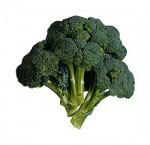 The cool weather of spring and fall invites the planting of broccoli, a vegetable that is tasty, versatile, and good for you. A ½ cup of cooked fresh broccoli contains 23 calories and two anti oxidants, beta carotene and vitamin C, that help ward off cancer especially colon and rectal cancer. Broccoli is delicious raw with a dip or in salad, steamed with our without a sauce, in stir fry, and as part of a casserole. It teams well with chicken, turkey, beef, and ham and makes a hearty soup with cheese. If nothing I have mentioned tempts you, consider that it makes a wonderful addition to flower arrangements. Yes, broccoli can be classified as floral; those tiny green nobs that are eaten are the buds of flowers that open with yellow petals if left in the garden or refrigerator too long.
The cool weather of spring and fall invites the planting of broccoli, a vegetable that is tasty, versatile, and good for you. A ½ cup of cooked fresh broccoli contains 23 calories and two anti oxidants, beta carotene and vitamin C, that help ward off cancer especially colon and rectal cancer. Broccoli is delicious raw with a dip or in salad, steamed with our without a sauce, in stir fry, and as part of a casserole. It teams well with chicken, turkey, beef, and ham and makes a hearty soup with cheese. If nothing I have mentioned tempts you, consider that it makes a wonderful addition to flower arrangements. Yes, broccoli can be classified as floral; those tiny green nobs that are eaten are the buds of flowers that open with yellow petals if left in the garden or refrigerator too long.
Here are ten tips for growing this wonderful vegetable.
1. Grow in cool weather only, that is spring or fall in most of the country. Broccoli is frost hardy and grows best when temperatures are under 85 degrees.
2. Buy seedlings rather than start from seed so that you can get the plants established quickly and bearing their crop, which takes between 55 and 60 days.
3. Heat tolerance and side shoot tolerance are important considerations in choosing broccoli varieties. Good varieties for home gardens include ‘Cruiser’, ‘Green Comet’, ‘Green Goliath’, ‘Green Hornet’,’ Packman’, and ‘Premium Crop’. Realistically, you will probably not have much choice as to variety; local retailers often carry the best variety for the area so give whatever they have a try.
4. Choose and prepare a site in full sun with reasonable fertile, well-drained moist soil high in organic matter with a pH between 6.0 and 7.0. Soil test results will give you specific recommendations for any crop you specify.
5. Set out seedling about 2 weeks before the last frost in spring; for autumn planting count back from the first frost 10 days plus the “days to harvest’. Plant seedlings 18”-24” apart with 24”-36” between rows.
6. Fertilize when planting with 20:20:20 liquid fertilizer according to directions and then again with high nitrogen fertilizer when the plants are about half grown.
7. Water regularly, making sure that the plants get at least 1-1 ½” per week. A much will help keep the soil evenly moist.
8. Watch for white, gray, or brown moths hovering around your plants; they lay their eggs on broccoli and other related crops. The caterpillars that develop from the eggs are voracious eaters and will probably destroy your crop. Covering your broccoli with nets before they arrive is the best way to prevent damage. Aphids can also be a problem but can be removed with a forceful jet of water or a garlic in water spray you can concoct at home.
9. ‘Buttons’ may form if conditions are unfavorable (like drought or heat). Buttons are tiny heads that form under stress.
10. Harvest when heads are large and firm and the flowers forming the heads are still tight green buds. Cut stems about 5-6” long but don’t discard the plants as side shoots can form more (but smaller) heads in the axils of the leaves for several weeks.
Store the unwashed broccoli in a plastic bag in your refrigerator for 5 days or more but it is definitely better when used by the 5th day. Watch for mold and for yellowing that is the result of the broccoli flowers opening their yellow petals. These open flowers can be eaten in salads and used effectively as a garnish on pasta or other foods.

The flower arrangement idea is neat. Broccoli definitely are gorgeous in the garden. I never noticed moths around ours last year, but they must have been there. Toward the end of the season, we cooked some of our broccoli and set it at the table. I took some only to find pretty, cooked green caterpillars on the broccoli I was about to eat. They blend in well. Needless to say, I lost my appetite!
Jackie,
I’m glad you mentioned the caterpillars; you’re right, they blend it well which makes it very hard to find them. I have the same problem with slugs on the lettuce and they even stand out on the lettuce leaves!
Karen